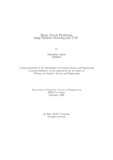Heart attack prediction using machine learning and XAI

View/
Date
2022-09Publisher
Brac UniversityAuthor
Ahsan, MumtahinaMetadata
Show full item recordAbstract
Predictive analytics has received a lot of attention in recent years due to advances
in supporting technology, particularly in the areas of big data and machine learning.
In recent years, the uses of disease prediction has been seen in the healthcare area.
Among so many predictions, this project will show the prediction of a heart attack.
Heart disease, often known as cardiovascular disease, refers to a variety of illnesses
that affect the heart and has become the leading cause of mortality worldwide in re cent decades. It links a slew of risk factors for heart disease with a pressing need for
precise, dependable, and practical methods for making an early diagnosis and man aging the condition. In the healthcare industry, data mining is a typical methodology
for analyzing large amounts of data. Because predicting cardiac illness is a difficult
undertaking. It is necessary to automate the process in order to avoid the risks
connected with it and to inform the patient well in advance. Heart diseases can be
determined using data mining techniques such as XGBOOST, Logistic Regression,
Stochastic Gradient Descent, Support Vector Classifier, Kneighborsclassifier, and
Naive Bayes. With this project, I have shown that among all the above machine
learning models, XGBOOST outperforms other techniques in terms of predicting
heart attacks. As a result, this paper conducts a comparative study of the perfor mance of several machine learning algorithms. For any type of prediction features
of the dataset plays a very important role. Features can give positive or negative
impact on the final prediction. The features importance can be visualized by the
XAI methods. This paper also takes an approach to interpret the explainability of
the model’s prediction. By using the XAI method SHAP and LIME with the help
of the concept of black box, this research conducts the KNN algorithms prediction.
